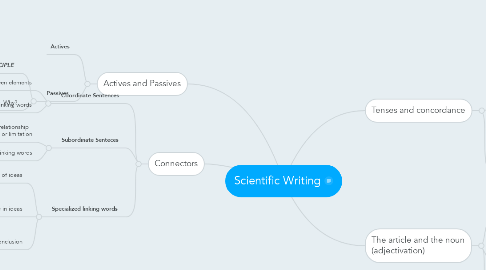
1. Actives and Passives
1.1. Actives
1.2. Passives
1.2.1. BE + PAST PARTICIPLE
1.2.2. Why?
1.2.2.1. It lets the facts stand on their own
1.2.2.2. Removes some accusations of bias
1.2.2.3. Give a sensation of logic
2. Connectors
2.1. Coordinate Sentences
2.1.1. Equality between elements
2.1.2. Linking words
2.1.2.1. and, or, but, for, nor, so, yet
2.2. Subordinate Senteces
2.2.1. Inequality or a relationship of dependence or limitation
2.2.2. Linking words
2.2.2.1. if, as, when, because
2.3. Specialized linking words
2.3.1. Reinforcement of ideas
2.3.1.1. Also, in other words, in addition, for example, moreover, more importantly
2.3.2. Change in ideas
2.3.2.1. But, on the other hand, however, instead, yet, in contrast, although, nevertheless, in spite of [something]
2.3.3. Conclusion
2.3.3.1. Thus, therefore, accordingly, in conclusion, finally, so [informal]
3. Tenses and concordance
3.1. Tense
3.1.1. PAST TENSE
3.1.1.1. Methodology
3.1.1.2. Results
3.1.2. PRESENT TENSE
3.1.2.1. Accepted facts
3.1.2.2. Results discussion
3.1.2.3. Conclusions
3.1.3. FUTURE TENSE
3.1.3.1. Possible future events
3.2. Concordance
3.2.1. Subjet and verb have to agree in number
4. The article and the noun (adjectivation)
4.1. Article
4.1.1. Singular/Plural
4.1.1.1. Depending on the number of the entity/entities
4.1.2. Definite/Indefinite
4.1.2.1. Depending on the referred entity
4.2. Noun
4.2.1. Depending on its specifity and number, different articles wil be used
4.2.2. Proper Nous
4.2.2.1. No article, except for proper nouns referring to geographical features
4.3. Adjetivation
4.3.1. Order:
4.3.1.1. Averb
4.3.1.1.1. Adjective
